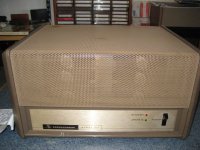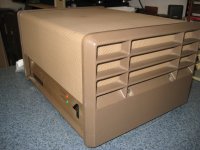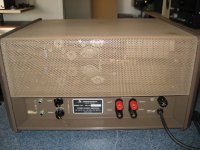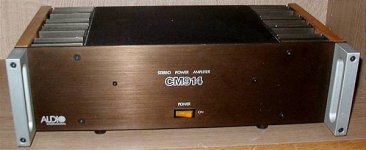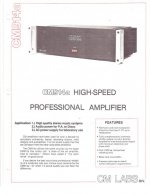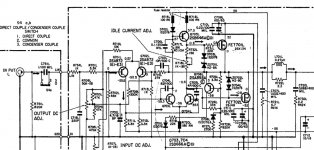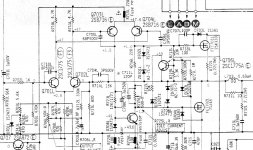I do think that we have most of the complementary designs from the '60's. The last design that came out in about 1968 that was pretty good, was the Marantz 14 and 15.
It measured pretty well on SMPTE IM distortion, had Motorola complementary output transistors, perhaps selected 2N3617-2N3792 pairs. The driver stage was similar to what Dick Burwen designed in 1966 as a discrete op amp for ADI. This circuit has the current mirror turn around driver stage. I bought one in 1969, but after listening with it driving my K-horn for a number of weeks, I went back to my own solid state designs. My own designs still did not sound as good as the Radiocraftsman triode 15W power amp with my k-horn, so it was back to the drawing board. It is interesting that the primary designer for the Radiocraftsman triode and the Marantz 7,9 and the solid state 14,15 were all designed by the same designer. Brilliant designer, met him once, it was Sid Smith. I wish I had known him better.
It measured pretty well on SMPTE IM distortion, had Motorola complementary output transistors, perhaps selected 2N3617-2N3792 pairs. The driver stage was similar to what Dick Burwen designed in 1966 as a discrete op amp for ADI. This circuit has the current mirror turn around driver stage. I bought one in 1969, but after listening with it driving my K-horn for a number of weeks, I went back to my own solid state designs. My own designs still did not sound as good as the Radiocraftsman triode 15W power amp with my k-horn, so it was back to the drawing board. It is interesting that the primary designer for the Radiocraftsman triode and the Marantz 7,9 and the solid state 14,15 were all designed by the same designer. Brilliant designer, met him once, it was Sid Smith. I wish I had known him better.
Last edited:
Interesting discussion.
Take a look at the link below:-
http://users.ece.gatech.edu/~mleach/papers/tcir/tcir.pdf
I guess there are a few improvements we've made since 1966 but, what I find interesting in the circuit is the use of degeneration on the input LTP. Clearly Bart Locanthi new a thing or two about signal dynamics and feedback.
However, for me his 'T' absolutely rocks.
Take a look at the link below:-
http://users.ece.gatech.edu/~mleach/papers/tcir/tcir.pdf
I guess there are a few improvements we've made since 1966 but, what I find interesting in the circuit is the use of degeneration on the input LTP. Clearly Bart Locanthi new a thing or two about signal dynamics and feedback.
However, for me his 'T' absolutely rocks.
Hello,
Actually, the whole complementary concept is maybe a 20th century technological hoax, as the ear feels uncomfortable when you have some 3rd and 5th harmonics as THD, but no 2th nor 4th harmonics. Unfortunately, that's exactly what you are going to get using full complementary designs. The ear wants to get some 2th and 4th harmonics inbetween. The only way to get this, is NOT to use a full complementary approach. That's what they did with the NAD3020. A semi-complementary design, using 2N3055 devices. And I can tell you, the NAD3020 amplifier sounds great, it gives a sensation of warmness and power, without being overprocessed.
Which may explain why there are so few commercial amplifiers using a complementary 2N3055/2N2955 pair ?
And, at this stage, we still don't know who :
a) first proposed complementary bipolar AB (or class A)
b) first successfully implemented it as an audio power amp
c) first used the venerable 2N3055/2N2955 pair in a product
That was the question, indeed !
Cheers,
Steph
Thank you for your very interesting explanation.
I agree and for this reason I also prefer quasi complementary concepts/topologies. Therefore I have make an overview about such topologies:
http://www.diyaudio.com/forums/soli...better-audio-non-complements-audio-power.html
http://www.diyaudio.com/forums/soli...e-ended-related-solid-state-output-stage.html
An more exotic concept than the NAD3020 you will find by a newer NAD modell: the NAD310. Here is a MOSFET in the upper (positive) half and a BjT in the lower half of the power buffer stage -
http://www.diyaudio.com/forums/soli...roach-special-kind-thd-mosfet-bjt-new-me.html
If you see the circuit, you cannot believe, how good is the sound by only 30mA idle current.
The 2N2955 isn't a complement of 2N3055:
Data sheet for 2N2955 from American Microsemiconductor, Inc. in Bipolar RF Transistors on GlobalSpec
it is an old germanium type from ON-Semi (formerly Motorola) in the TO-18 outline
Therefore I cannot understand, why the brand UTC offer this transistor in TO-3.
The actually complement of 2N3055 is the BDX18 from ST, and MJ2955 from ON/Motorola. By the successors in smaller outline like TO220 (MOT) and TOP3 (TI) however we have pairs with the same letters: MJE2955/MJE3055 and TIP2955/TIP3055.
The first true complementary silicon transistor pair in Europe must actually be the BD131A/BD132A from Mullard/Philips, as I have note in an old transistor data comparison table (60V/3A/11W).
about
http://homepage2.nifty.com/~mhitaste/audiotop/dcamp_parts/dc_ampparts020.html
you will find a lot of old TO66 complements
Last edited:
Interesting discussion.
Take a look at the link below:-
http://users.ece.gatech.edu/~mleach/papers/tcir/tcir.pdf
I guess there are a few improvements we've made since 1966 but, what I find interesting in the circuit is the use of degeneration on the input LTP. Clearly Bart Locanthi new a thing or two about signal dynamics and feedback.
However, for me his 'T' absolutely rocks.
Thank you for this URL - the supplement to
http://www.harman.com/EN-US/OurComp...ip/Documents/Scientific Publications/1091.pdf
and
http://www.jblproservice.com/pdf/Vintage JBL-UREI Electronics/JBL-SA600~SA660.pdf
One thing I have overlooked (look at fig. 4-6 page 36 of sm): the first true complementary silicon pair for very high power applications don't use the JEDEC type numbering (also not the JIS and not the ProElectron) Motorola's 12536 and 12537 you will not find in any Motorola's databook for industry standard power devices. For this reason it isn't easy to find the first commercial amp component employed this.
Last edited:
These are factory part numbers that should correspond to the 2N3716 and 2N3792. They just got them re-marked at the factory. The same devices we used at Ampex had a different part number, but they were the same as, or specifically picked parts from that series. That was all there was at that time. Also look at the PRICE of the PNP power part in the JBLproservice manual at the the time. Over $20, or 20 lunches at the time.
This is the main reason, why most commercial amplifier topologies uses quasi complementary output staged or transformer coupled versions instead true complementary output buffer stages well into the seventies.These are factory part numbers that should correspond to the 2N3716 and 2N3792. They just got them re-marked at the factory. The same devices we used at Ampex had a different part number, but they were the same as, or specifically picked parts from that series. That was all there was at that time. Also look at the PRICE of the PNP power part in the JBLproservice manual at the the time. Over $20, or 20 lunches at the time.
Also, the germanium transistors - which were at least in Germany for a long time still significantly cheaper than the 2N3055 have been displaced not so fast - look at this URL for various schematics:
AD149 - Google Search
BTW - it would be interesting to know, at which time this types are released about the JEDEC number 2N3716 and 2N3792. The factory number 12536 and 12537 are released already earlier than January 1967 (look about the link from Bonsai from post #45)
We were all waiting for the complementary output pair, hoping for a new age in solid state power amp design.
And we are still waiting
http://users.ece.gatech.edu/~mleach/papers/tcir/tcir.pdf
I guess there are a few improvements we've made since 1966 but, what I find interesting in the circuit is the use of degeneration on the input LTP. Clearly Bart Locanthi new a thing or two about signal dynamics and feedback.
However, for me his 'T' absolutely rocks.
Thanks, I was looking for the original article for awhile.
I was exposed to the 2N3716-2N3792 combination in 1966, while working at Friden, by the Motorola Reps. over lunch, provided by them. The next generation of Motorola devices came from a similar device pair, called the 2N5031 and the 2N6031. This was the basis of the later amps, like SAE and Ampzilla. The 2N5884 and 2N5886 was my personal choice between 1970-1975. This was only an 80V part, but had better safe area than the 2N3716-2N3792. The 2N5684-2N5686 combination was available in 1969 and had 300W dissipation in each device and 50A capability, BUT the safe area was less than the 2N5884-6 combination and therefore had to be more carefully utilized to prevent 2'nd breakdown.
Very interesting. Unfortunately I have not found in the older German magazine "Funkschau" (in this time good known and many articles arround "Audio/HiFi") information about its part "News". I think, the most commercial power amps that employed 2N3716-2N3792 generations mainly offered in your country and Kanada and not in the German marked at this time.I was exposed to the 2N3716-2N3792 combination in 1966, while working at Friden, by the Motorola Reps. over lunch, provided by them. The next generation of Motorola devices came from a similar device pair, called the 2N5031 and the 2N6031. This was the basis of the later amps, like SAE and Ampzilla. The 2N5884 and 2N5886 was my personal choice between 1970-1975. This was only an 80V part, but had better safe area than the 2N3716-2N3792. The 2N5684-2N5686 combination was available in 1969 and had 300W dissipation in each device and 50A capability, BUT the safe area was less than the 2N5884-6 combination and therefore had to be more carefully utilized to prevent 2'nd breakdown.
Telstar: for the 2N3055 the BDX18 and MJ2955 are complements (much more newer than the 2N3055); same situation for the 2N3773 (2N6609).
Flipping burgers back then, John? My dad (a tradesman) was earning $9-10/hour in 1966. It wasn't 1936.
..Todd
The average weekly engineering wage in 1966 could have been anywhere from $100 - $200 depending on experience and credentials. (Cal, NYC, parts of New England, elsewhere would probably have been less.) This would be roughly equivalent to an engineering salary range of $60K - $120K today in terms of experience and responsibility. To provide perspective my Dad w/Cornell MSEE who was by this time (1966) managing a division of a significant defense contractor made somewhat less than you report your dad was earning.
Last edited:
Yes, tief, the Europeans were falling behind the USA at this time with semiconductors of this type. I suspect that the military-industrial complex's needs for the 'cold war' fueled most of this development in the USA. The 2N3773 was also used, of course, and it was very rugged, compared to the comp. pairs, but it had to be used in quasi-comp output, rather than full comp., and it was a slower device, which was a problem with hi fi amps. For motor drives, we often used the 2N3773.
Before the Motorola complements, there was also an "arranged marriage" between the TIXP07 (a PNP), and a 2N something, in the low figures, 1500 to 2000 (NPN), I dont quite remember.
I have an application paper somewhere, I'll try to find it. It was for 10 or 20W output power.
I have an application paper somewhere, I'll try to find it. It was for 10 or 20W output power.
CM lab 911 and 914 (CM911, CM914)
one of this amps could also be one of the earliest models with complementary power devices - unfortunately not exactly to determine because there are no schematics:
one of this amps could also be one of the earliest models with complementary power devices - unfortunately not exactly to determine because there are no schematics:
Attachments
Already done in 1978 and 1979 by Hitachi, in their first power amplifiers demonstrating the advantages of their 2SJ/2SK lateral MOSFETs. Note the use of the current mirror as collector load for the VAS. That's an elegant evolution from Locanthi's January 1967 schematic. Audio-grade opamps like NE5534 and OPA134 have the same structure. Was Locanthi the originator, in January 1967, of such twin differential arrangement ?It would be an interesting exercise to build Bart Locanthi's amp exactly as it is but with modern improved components. Looks very simple and quite elegant.
Attachments
- Status
- This old topic is closed. If you want to reopen this topic, contact a moderator using the "Report Post" button.
- Home
- Amplifiers
- Solid State
- What was the first Complementary AB bipolar amplifiers?
